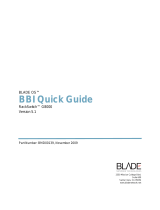
N8406-023 1Gb Intelligent L3 Switch Browser-based Interface Reference Guide 4
Viewing statistics
Introduction ........................................................................................................................................................... 59
Steps for displaying statistics ............................................................................................................................... 59
Management Processor Statistics ........................................................................................................................ 61
TCP/IP Statistics (IF and IP Statistics) ................................................................................................................. 62
TCP/IP Statistics (ICMP and TCP Statistics) ........................................................................................................ 64
UDP/SNMP Statistics ........................................................................................................................................... 67
CPU Utilization ..................................................................................................................................................... 69
FDB Statistics ....................................................................................................................................................... 70
Network Time Protocol Statistics .......................................................................................................................... 70
Switch Ports Statistics Summary .......................................................................................................................... 71
Switch Ports 802.1x Statistics .............................................................................................................................. 76
Port 802.1x Statistics ............................................................................................................................................ 77
FDB Statistics ....................................................................................................................................................... 79
LACP Statistics ..................................................................................................................................................... 80
IP Statistics ........................................................................................................................................................... 81
IP Routing Management Statistics (part one) ....................................................................................................... 82
ARP Statistics ....................................................................................................................................................... 87
IGMP VLAN Snooping Statistics Summary .......................................................................................................... 88
OSPF General Statistics ....................................................................................................................................... 90
OSPF Areas Statistics .......................................................................................................................................... 92
OSPF IP Interfaces Statistics ............................................................................................................................... 96
RIP Statistics ...................................................................................................................................................... 100
Virtual Router Redundancy Protocol Statistics ................................................................................................... 101
Domain Name System Statistics ........................................................................................................................ 101
Access Control Lists Statistics ............................................................................................................................ 102
Uplink Failure Detection Statistics ...................................................................................................................... 103
Configuring the switch
Introduction ......................................................................................................................................................... 104
Configuration steps ............................................................................................................................................. 104
Switch Management Processor Configuration ................................................................................................... 107
User Configuration Table .................................................................................................................................... 111
User Access Control Configuration .................................................................................................................... 112
Switch RADIUS Configuration ............................................................................................................................ 113
Switch TACACS+ Configuration ......................................................................................................................... 114
NTP Configuration .............................................................................................................................................. 116
Syslog and Trap Feature Configuration .............................................................................................................. 117
Switch Image and Configuration Management ................................................................................................... 119
Switch Ports Configuration ................................................................................................................................. 123
Port-Based Port Mirroring Configuration ............................................................................................................ 127
802.1x General Configuration ............................................................................................................................. 129
FDB Configuration .............................................................................................................................................. 131
VLANs Configuration .......................................................................................................................................... 133
Switch Spanning Tree Groups Configuration ..................................................................................................... 135
MSTP/RSTP General Configuration ................................................................................................................... 139
Trunk Groups Configuration ............................................................................................................................... 143
RMON History Configuration Table .................................................................................................................... 148
RMON Alarm Configuration Table ...................................................................................................................... 150
RMON Event Configuration Table ...................................................................................................................... 152
IP Interfaces Configuration ................................................................................................................................. 154
IP Static Routes Configuration ........................................................................................................................... 156
Static ARP Configuration .................................................................................................................................... 157
Network Filters Configuration ............................................................................................................................. 159
Route Maps Configuration .................................................................................................................................. 161
Default Gateways Configuration ......................................................................................................................... 164
Default Gateway Configuration ........................................................................................................................... 165
IGMP Snooping Configuration ............................................................................................................................ 166
OSPF General Configuration .............................................................................................................................. 171
OSPF Areas Configuration ................................................................................................................................. 172
OSPF Summary Ranges Configuration .............................................................................................................. 174
OSPF Interfaces Configuration ........................................................................................................................... 175
OSPF Virtual Links Configuration ....................................................................................................................... 177
OSPF Hosts Configuration ................................................................................................................................. 178
OSPF Route Redistribution Configuration .......................................................................................................... 180
RIP Interfaces Configuration .............................................................................................................................. 181






















